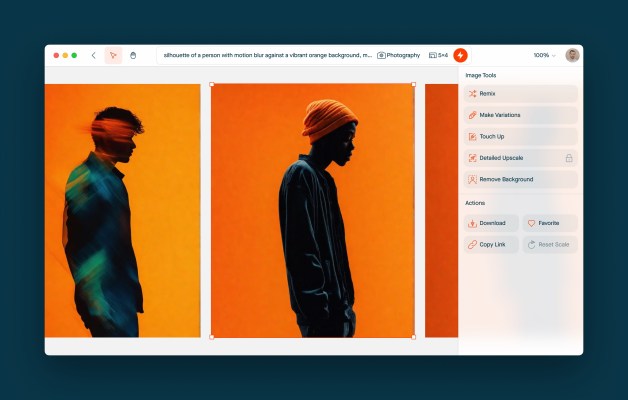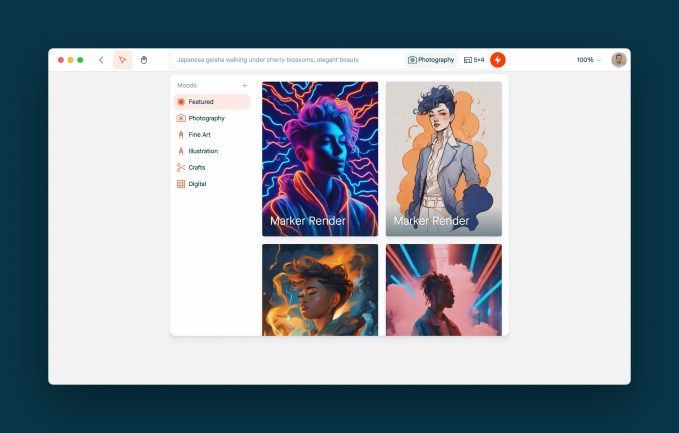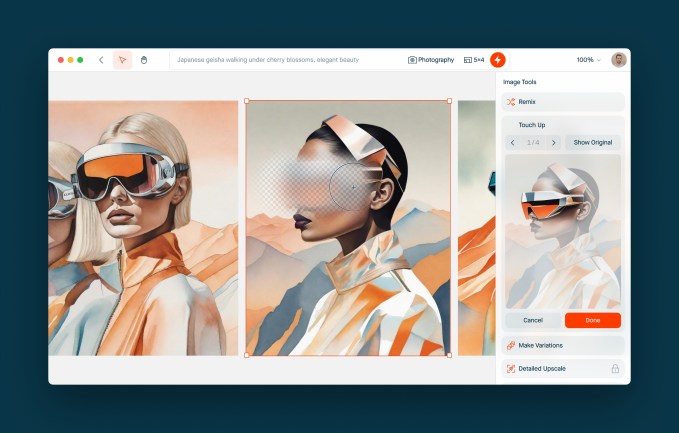Visual Electric launches an AI-powered image generator with a designer workflow focus

Visual Electric, a company backed by Sequoia Capital, has launched its generative AI-based image-generation tool aimed at designers.
The company was founded in November 2022 by CEO Colin Dunn, a former executive at Universe, a mobile building site (Dunn also worked at Facebook and Dropbox); Chief Product Officer Adam Menges, a former Apple employee whose startups Lobe (a design tool) and Lowkey (an AR game company) were acquired by Microsoft and Niantic, respectively; and Chief Technology Officer Zach Stiggelbout, who worked at Microsoft on Lobe.

Image Credits: Visual Electric
Dunn told TechCrunch over a call that a lot of generative AI-based image creation interfaces are not focused on the workflows of designers.
“We started Visual Electric because generative AI is an interface problem. Existing tools rely on a linear chat metaphor. But creativity isn’t linear, it’s messy. So we built our product around the creative process. Our generative canvas lets you spread out, make a mess and work spatially,” he said.
Dunn said that AI-based image generation is probably still in a “pre-ChatGPT era.” What he means is that existing image-creation solutions haven’t reached the mass appeal of ChatGPT. Visual Electric launched its beta in February for graphic designers, ad creatives and concept artists working in companies such as Stripe, Affirm and Riot Games, and design studios like Instrument and Manual.
The CEO mentioned that a lot of its existing users were looking for solutions where they could easily create an image and modify it or iterate on it till they reached a satisfactory stage.
How does the platform work?
The interface is simple to get started: You have to type in a prompt to get four options based on an infinite canvas. You can iterate as many times as you want to generate a suitable image for your project. While writing a prompt, you can also select a color palate, what colors to exclude, format and a mood including Airbrush, Film, Cinematic and Neon.
The tool is free to use but there is a cap of 40 image generations per day. You can pay for the premium plan that starts at $16 per month for better generation speeds and no limit on image creation along with a license to use these pictures commercially. Visual Electric said that under both these plans, any image you generate is shared with the community. However, if you pay for the top-tier $48 per month plan, your snaps are private and you get even better speed for image generation.
The tool also has features like “touch” to modify different parts of a generated picture with a prompt, an upscaling feature for premium users, the ability to remove the background or make variations by changing the “creativity” slider and a “remix” feature to give an existing image a makeover.
The company was founded in 2022 and it has raised $2.5 million in funding from Sequoia, BoxGroup and Designer Fund.

Image Credits: Visual Electric
Visual Electric uses Stable Diffusion as the image generation model along with GPT-3.5 Turbo to power auto-generated prompt suggestions. The tool also deploys GPT-4 to generate a prompt from an imported image.
The company doesn’t have a mobile app yet but is considering working on it next year.
In the last year, companies like Google, Meta, Amazon, Adobe and even Getty Images have launched many image-generation tools. Chatbot platforms like ChatGPT and Poe have also integrated image generations for easier access.
Visual Electric thinks that its focus on a specific set of users will give it an edge. Recently, other tools like Vercel and TLDraw — which recently raised an additional $2 million in funding — have also experimented with interface-generating features.
